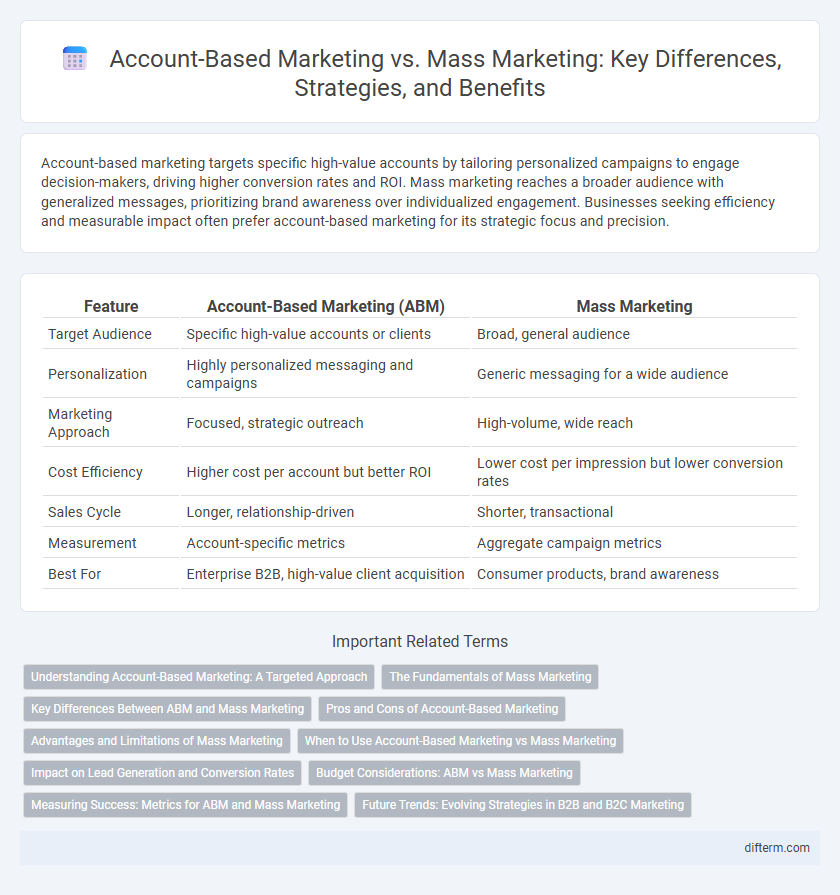Account-based marketing targets specific high-value accounts by tailoring personalized campaigns to engage decision-makers, driving higher conversion rates and ROI. Mass marketing reaches a broader audience with generalized messages, prioritizing brand awareness over individualized engagement. Businesses seeking efficiency and measurable impact often prefer account-based marketing for its strategic focus and precision.
Table of Comparison
| Feature | Account-Based Marketing (ABM) | Mass Marketing |
|---|---|---|
| Target Audience | Specific high-value accounts or clients | Broad, general audience |
| Personalization | Highly personalized messaging and campaigns | Generic messaging for a wide audience |
| Marketing Approach | Focused, strategic outreach | High-volume, wide reach |
| Cost Efficiency | Higher cost per account but better ROI | Lower cost per impression but lower conversion rates |
| Sales Cycle | Longer, relationship-driven | Shorter, transactional |
| Measurement | Account-specific metrics | Aggregate campaign metrics |
| Best For | Enterprise B2B, high-value client acquisition | Consumer products, brand awareness |
Understanding Account-Based Marketing: A Targeted Approach
Account-based marketing (ABM) focuses on personalized campaigns tailored to specific high-value accounts, delivering targeted messaging that resonates with key decision-makers. Unlike mass marketing, which casts a wide net to reach a broad audience, ABM prioritizes quality over quantity by aligning sales and marketing efforts to individual account needs. This targeted approach increases engagement, improves conversion rates, and drives higher ROI by addressing the unique challenges and goals of each account.
The Fundamentals of Mass Marketing
Mass marketing targets a broad audience with generalized messaging to maximize reach and brand awareness. It relies on high-volume campaigns using traditional media channels such as television, radio, and print to create widespread appeal. The fundamental approach emphasizes product uniformity and cost-efficiency rather than personalized communication and segmentation, distinguishing it from account-based marketing strategies.
Key Differences Between ABM and Mass Marketing
Account-based marketing (ABM) targets specific high-value accounts with personalized campaigns, whereas mass marketing aims to reach a broad audience with general messaging. ABM emphasizes quality over quantity by tailoring content to individual decision-makers, resulting in higher engagement and ROI. In contrast, mass marketing relies on volume and brand awareness, using wide-reaching channels like TV, radio, and online ads to maximize exposure.
Pros and Cons of Account-Based Marketing
Account-based marketing (ABM) targets high-value accounts with personalized campaigns, resulting in increased ROI and stronger client relationships compared to mass marketing. By concentrating resources on specific accounts, ABM enhances lead quality and shortens the sales cycle, though it requires significant upfront investment and detailed account research. This approach may limit scalability but offers precise alignment between marketing and sales teams, maximizing efficiency for B2B organizations.
Advantages and Limitations of Mass Marketing
Mass marketing optimizes reach by targeting a broad audience, resulting in high brand awareness and cost efficiency through standardized campaigns. Its advantages include simplified message delivery and economies of scale, making it ideal for products with universal appeal. However, mass marketing faces limitations such as low personalization, reduced engagement, and potential waste of resources on uninterested segments, which can diminish overall campaign effectiveness.
When to Use Account-Based Marketing vs Mass Marketing
Account-based marketing (ABM) excels when targeting high-value accounts with personalized campaigns aimed at decision-makers, optimizing ROI through tailored messaging and engagement. Mass marketing suits products or services with broad appeal, leveraging wide-reaching channels to maximize brand awareness and lead generation at scale. Companies should use ABM for complex B2B sales cycles and strategic account acquisition, while deploying mass marketing for consumer goods or offerings requiring extensive market penetration.
Impact on Lead Generation and Conversion Rates
Account-based marketing (ABM) delivers higher lead quality by targeting specific high-value accounts, resulting in improved conversion rates compared to mass marketing's broad approach. ABM strategies enable personalized content and tailored campaigns that resonate with decision-makers, significantly increasing engagement and accelerating the sales cycle. Mass marketing generates a larger volume of leads but often suffers from lower conversion rates due to generalized messaging that fails to address individual prospect needs.
Budget Considerations: ABM vs Mass Marketing
Account-based marketing (ABM) typically requires a higher upfront investment due to personalized content creation and targeted technology tools, making it cost-effective for high-value accounts. In contrast, mass marketing operates on lower per-unit costs by reaching a broad audience but may result in higher overall expenses without guaranteed conversions. Budget allocations for ABM emphasize quality and precision, whereas mass marketing budgets prioritize scale and reach.
Measuring Success: Metrics for ABM and Mass Marketing
Account-based marketing (ABM) success is measured by metrics such as account engagement, deal velocity, and customer lifetime value, reflecting personalized targeting efforts. Mass marketing relies on broad metrics like reach, impressions, click-through rates, and overall conversion rates to gauge campaign effectiveness. Comparing these metrics highlights ABM's focus on quality and depth of engagement versus mass marketing's emphasis on volume and brand awareness.
Future Trends: Evolving Strategies in B2B and B2C Marketing
Account-based marketing (ABM) leverages personalized targeting and data analytics to engage high-value B2B clients, while mass marketing employs broad messaging to reach diverse B2C audiences. Future trends emphasize integrating AI-driven insights and omnichannel strategies to optimize ABM's precision and enhance mass marketing's scalability. The convergence of these approaches aims to create adaptive, customer-centric campaigns that maximize ROI in evolving digital marketplaces.
Account-based marketing vs mass marketing Infographic

 difterm.com
difterm.com